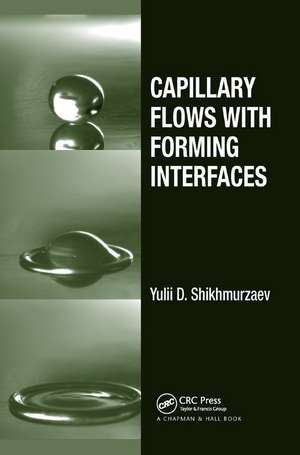Capillary Flows with Forming Interfaces
Autor Yulii D. Shikhmurzaeven Limba Engleză Paperback – 18 oct 2019
The book begins with a review of the conceptual framework of fluid mechanics and then proceeds to analyze the roots of singularities, such as the moving contact-line problem and the capillary breakup problem. The author then examines how different singular flows can be described as particular cases of a general physical phenomenon of interface formation. He illustrates the developed mathematical models and experimentally verifies them through a number of example problems relevant to engineering applications.
The conceptual framework provided in this reference enables further progress in developing mathematical models of capillary flows.
The book also allows readers to make informed strategic choices regarding available numerical codes and the in-house development of these codes.
Preț: 378.95 lei
Preț vechi: 482.13 lei
-21% Nou
Puncte Express: 568
Preț estimativ în valută:
72.52€ • 75.25$ • 60.61£
72.52€ • 75.25$ • 60.61£
Carte tipărită la comandă
Livrare economică 17-31 martie
Preluare comenzi: 021 569.72.76
Specificații
ISBN-13: 9780367388652
ISBN-10: 0367388650
Pagini: 480
Dimensiuni: 156 x 234 mm
Greutate: 0.92 kg
Ediția:1
Editura: CRC Press
Colecția Chapman and Hall/CRC
ISBN-10: 0367388650
Pagini: 480
Dimensiuni: 156 x 234 mm
Greutate: 0.92 kg
Ediția:1
Editura: CRC Press
Colecția Chapman and Hall/CRC
Cuprins
Introduction. Fundamentals of Fluid Mechanics. Moving Contact Lines: An Overview. Boundary Conditions on Forming Interfaces. Moving Contact Lines: Mathematical Description. Cusps, Corners, and Coalescence of Drops. Breakup of Jets and Rupture of Films. Appendices. References. Indices.
Descriere
This self-contained book explores various theoretical problems that arise in the mathematical description of capillary flows, such as the spreading of liquids on solids and the formation of drops, where conventional modeling leads to nonphysical singularities. It examines the advantages and disadvantages of theoretical approaches to modeling singular flows and identifies a common physical mechanism behind seemingly different singular capillary phenomena. This unifying approach forms the basis for simple, ready-to-use, experimentally verified models along with many solutions that illustrate the models' application to problems of practical importance.
